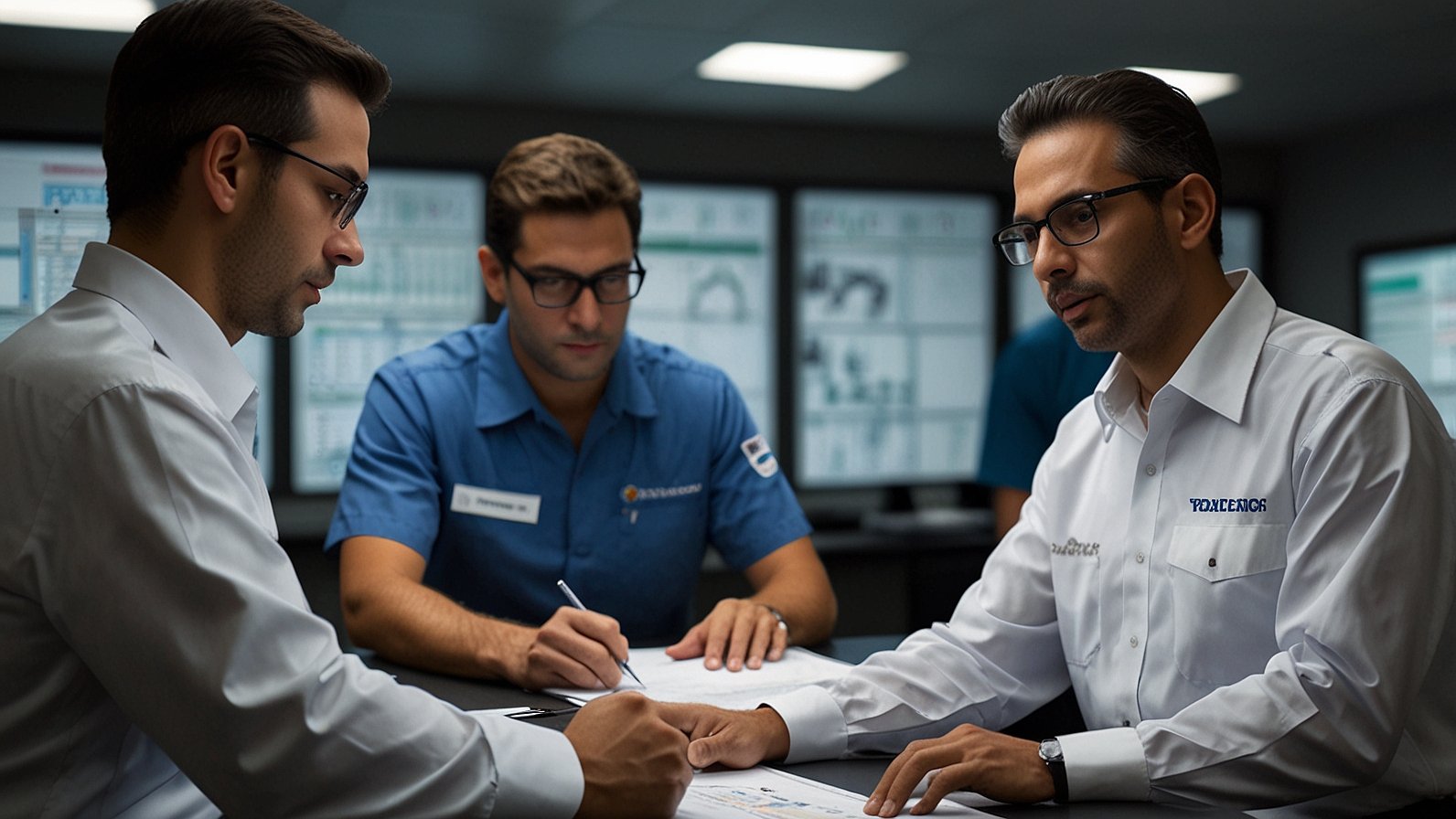Imagine a busy hospital emergency room in São Paulo. Amidst the controlled chaos, a nurse administers a critical medication. One missed step, one unclear instruction, could have serious consequences. Yet, confidence prevails. Why? Because a meticulously crafted Protocolo Operacional Padrao (POP) guides every action, ensuring consistency and safety, even under pressure. In Brazil, where operational excellence meets complex regulatory landscapes, the POP isn’t just paperwork – it’s the backbone of reliability across countless industries.
What Exactly is a Protocolo Operacional Padrao (POP)?
Think of a POP as the ultimate recipe book for getting things done right, every single time, within a Brazilian organization. It’s far more than a simple checklist. A Protocolo Operacional Padrao is a formal, documented Standard Operating Procedure (SOP). Its core purpose? To provide crystal-clear, step-by-step instructions for performing specific operational tasks or processes with unwavering consistency.
- The Blueprint for Consistency: It eliminates guesswork and “that’s how we’ve always done it” variations by defining the one best way to execute a task.
- Guardian of Quality & Safety: By standardizing processes, POPs are fundamental tools for maintaining high-quality outputs and, crucially, ensuring the safety of employees, customers, patients, or the public.
- Compliance Cornerstone: In a country with robust regulatory frameworks (like ANVISA in health, ANAC in aviation, ANP in oil & gas), POPs serve as tangible proof that an organization adheres to legal and industry-specific norms and regulations.
- Knowledge Preserver: They capture valuable institutional knowledge and expertise, preventing it from walking out the door when experienced staff leave.
Why POPs Are Non-Negotiable in the Brazilian Context
Brazil’s diverse and dynamic economy, coupled with stringent regulatory oversight, makes standardized procedures essential. Here’s why POPs are indispensable:
- Navigating Complexity: Brazilian regulations (like NRs – Normas Regulamentadoras for labor) can be intricate. POPs translate these complex requirements into actionable steps for frontline workers.
- Scaling with Quality: Whether it’s a national retail chain, a multi-site hospital network, or an expanding manufacturer, POPs ensure that operations deliver the same standard of quality and safety regardless of location or team.
- Risk Mitigation: Standardization directly reduces errors, accidents, and non-compliance incidents, protecting people, the environment, and the company’s reputation and finances.
- Efficiency Engine: Clear procedures minimize wasted time, resources, and rework, streamlining operations and boosting productivity.
- Training Foundation: POPs are the go-to resource for onboarding new employees and upskilling existing staff, ensuring everyone is literally “on the same page.”
Building a Bulletproof POP: It’s a Team Sport
Creating an effective POP isn’t a task for a lone writer tucked away in an office. It demands collaboration and expertise.
- The Players: Cross-functional teams are essential. This includes:
- Subject Matter Experts (SMEs): The people who actually do the job daily. Their hands-on experience is gold.
- Quality Assurance/Control: Ensuring the procedure meets internal quality standards and external regulations.
- Management/Leadership: Providing oversight, resources, and ensuring alignment with strategic goals.
- Technical Writers (Often): To help structure, clarify, and format the document effectively.
- The Game Plan (Key Steps):
- Define Scope & Objective: What specific process or task does this POP cover? What’s the precise goal?
- Gather Intel: Observe the current process, interview SMEs, review existing docs, and identify regulations.
- Draft Meticulously: Write clear, sequential steps. Use simple language. Define all terms. Include warnings and safety precautions prominently.
- Review & Revise: The cross-functional team must scrutinize the draft for accuracy, completeness, safety, and usability. This is iterative.
- Approve Formally: Designated authorities (often Quality, Safety, and relevant Department Heads) give final sign-off.
- Implement & Train: Roll out the POP with comprehensive training for all affected personnel.
- Maintain & Update: POPs are living documents. Regular reviews (e.g., annually, or after incidents/process changes) are mandatory.
Essential Anatomy of a Powerful POP Document
While formats can vary slightly by industry or company, a robust POP typically includes these core elements:
| Core Section | Purpose | Essential Content |
|---|---|---|
| 1. Identification | Basic Document Info | Title, Unique POP Code/Nº, Effective Date, Version Nº, Review Date, Page Numbers |
| 2. Scope & Objective | Sets Boundaries & Goal | What specific process/task is covered? Why does this POP exist? (e.g., ensure safety, meet regulation X, achieve quality Y) |
| 3. Responsibilities | Defines Who Does What | Clear listing of roles involved in executing the procedure and those responsible for maintaining/approving the POP itself. |
| 4. Definitions & Acronyms | Ensures Clarity | Explanation of technical terms, jargon, or abbreviations used within the document. |
| 5. Required Materials/Equipment | Preparation Checklist | List of everything needed before starting (tools, PPE, chemicals, forms, software). |
| 6. Step-by-Step Procedure | The Core Instructions | Detailed, sequential steps. Use numbered lists. Include what to do, how to do it, when, and where. Integrate critical Safety Warnings (CAUTION, WARNING, DANGER) and Quality Checkpoints. |
| 7. Associated Documents & References | Provides Context | Links to related forms, other POPs, manuals, safety data sheets (SDS/FISPQ), and relevant regulations (NRs, ISO standards, ANVISA resolutions). |
| 8. Revision History | Tracks Changes | Table showing version number, date of change, description of change, and who approved it. |
| 9. Approval Signatures | Formal Authorization | Signatures/names and dates from all designated approvers (QA, Safety, Dept. Head, etc.). |
Also Read: Kennedy Funding Complaints: What Borrowers Need to Know Before Signing
Bringing the POP to Life: Implementation is Key
A beautifully written POP gathering dust is worse than useless – it creates a false sense of security. Effective implementation is critical:
- Accessibility: POPs must be readily available where the work is done – on the shop floor, in the lab, at the nurse’s station. Digital access via tablets or company intranets is increasingly common.
- Comprehensive Training: Don’t just hand out the document. Conduct formal training sessions explaining the why behind the steps, demonstrating them, and allowing practice. Training records are crucial for audits.
- Understanding over Memorization: Staff should understand the principles and know where to find the POP, not necessarily memorize every word (though critical safety steps are an exception).
- Culture of Compliance: Leadership must actively champion POP adherence, making it clear that following the procedure is non-negotiable for safety and quality. Encourage questions and feedback.
- Monitoring & Auditing: Regularly observe work, conduct internal audits, and review process outputs to verify that POPs are being followed correctly and are still effective.
POPs in Action: Real-World Impact Across Brazilian Sectors
The Protocolo Operacional Padrao is a versatile tool applied universally:
- Healthcare (Hospitals, Clinics, Labs – ANVISA Focus):
- Example: Strict POPs govern medication administration (dosage, route, patient verification), surgical instrument sterilization, infection control protocols, and patient triage. A POP for hand hygiene isn’t just a suggestion – it’s a life-saving mandate. Failure to comply can lead to severe ANVISA sanctions.
- Aviation (ANAC Oversight):
- Example: From pre-flight checks performed by ground crews using detailed POPs, to standardized cockpit procedures for takeoff, landing, and emergencies followed by pilots and co-pilots, POPs are the bedrock of aviation safety. Every action is traceable back to a procedure.
- Manufacturing & Industry (Wide Range of NRs):
- Example: POPs define lockout/tagout (LOTO) procedures for machinery maintenance (critical for NR-10 and NR-12 compliance), safe chemical handling (NRs, FISPQ), quality control testing protocols (aligned with ISO 9001), and production line set-up sequences. They prevent accidents and ensure product uniformity.
- Food & Beverage (Vigilância Sanitária / MAPA):
- Example: POPs dictate hygiene practices, food storage temperatures, cooking times, cleaning and sanitation schedules for equipment, and allergen control procedures – essential for preventing contamination and illness, meeting MAPA and local health regulations.
- Oil, Gas & Energy (ANP, IBAMA, NRs):
- Example: High-risk environments demand rigorous POPs for drilling operations, refinery processes, emergency shutdowns, environmental spill response, and confined space entry. Safety and environmental protection are paramount.
- Regulatory Agencies (Internal Operations):
- Example: Even agencies like ANVISA, ANAC, or ANP use POPs internally to standardize their inspection processes, licensing application reviews, and enforcement actions, ensuring fairness and consistency.
The Standards Connection: POPs and Frameworks like ISO 9001
POPs aren’t created in a vacuum. They are a fundamental requirement of Quality Management Systems (QMS) like ISO 9001. Here’s how they connect:
- ISO 9001 Requirement: Clause 8.1 specifically requires organizations to “determine, implement and control the processes needed” to meet requirements. Documented procedures (POPs!) are the primary way to demonstrate this control.
- Evidence of Conformity: During an ISO 9001 audit, POPs are examined as evidence that processes are defined, understood, and consistently followed.
- Continuous Improvement Driver: The process of regularly reviewing and updating POPs (mandated by ISO 9001’s PDCA cycle – Plan, Do, Check, Act) is a key mechanism for driving operational improvements. Audit findings and process performance data feed directly back into POP revisions.
- Sector-Specific Standards: POPs also directly implement requirements from industry-specific standards (e.g., ISO 13485 for medical devices, ISO 22000 for food safety, API standards in oil & gas).
Overcoming Common POP Pitfalls
Even with the best intentions, POPs can fail. Watch out for these traps:
- Dusty Shelf Syndrome: Creating a POP but never training on it or ensuring it’s used.
- The Ivory Tower Effect: Writing POPs solely by managers or QA without deep input from the people actually doing the work, leading to unrealistic or impractical steps.
- Overly Complex or Vague Language: Using jargon, long sentences, or ambiguous terms (“do it carefully”) instead of clear, simple instructions.
- Neglecting Updates: Processes change, regulations evolve, equipment gets upgraded. An outdated POP is a dangerous POP.
- Lack of Ownership: No clear responsibility for maintaining, reviewing, and enforcing the POP.
- Focus Only on Compliance: While vital, POPs should also be seen as tools for efficiency, quality, and safety excellence, not just ticking an audit box.
Your Action Plan: Implementing or Enhancing POPs
Ready to harness the power of Protocolo Operacional Padrao? Here’s how to start or improve:
- Prioritize: Identify critical, high-risk, or error-prone processes that need standardization first.
- Assemble the Right Team: Get SMEs, QA, Safety, and management involved from the start.
- Use a Template: Adopt or create a standardized template (like the anatomy described earlier) for consistency.
- Keep it Simple & Visual: Use clear language, bullet points, numbered steps, and flowcharts or diagrams where helpful. A picture is worth a thousand words.
- Integrate Training: Budget time and resources for proper rollout training. Make it engaging.
- Make Access Easy: Ensure POPs are instantly accessible at the point of use – physically and/or digitally.
- Schedule Reviews: Put POP review dates on the calendar (e.g., annually, after incidents, process changes). Treat it as mandatory maintenance.
- Foster a Speak-Up Culture: Encourage employees to report issues with the POP or suggest improvements without fear. They are the eyes and ears on the ground.
- Leverage Technology: Consider digital SOP/POP management systems that track versions, control access, facilitate electronic signatures, and integrate with training records.
The Bottom Line: Consistency is King (and Queen)
In the dynamic and demanding landscape of Brazilian business and regulation, the Protocolo Operacional Padrao is far more than bureaucratic red tape. It’s the essential blueprint for operational excellence. It transforms complex tasks into reliable routines, safeguards people and assets, ensures product and service quality, and provides the documented proof needed to navigate regulatory requirements. By investing in well-crafted, effectively implemented, and diligently maintained POPs, organizations don’t just comply – they build a foundation for sustainable success, safety, and trust. What’s the first process in your organization that could benefit from a POP review or creation?
You May Also Read: Kate Middleton is Reportedly Holding a Crucial Meeting. Inside Her Return to Royal Leadership
FAQs
Q: Is a POP the same as an SOP?
A: Essentially, yes! “Protocolo Operacional Padrao” (POP) is the Brazilian Portuguese term for a Standard Operating Procedure (SOP). They serve the same fundamental purpose: providing step-by-step instructions for consistent task execution.
Q: How detailed should a POP be?
A: Detailed enough to eliminate ambiguity for the trained user, but not so verbose it’s unusable. Focus on clarity, safety, and key quality checkpoints. Assume the reader has basic training but needs the specifics for this exact task. Use visuals if they clarify complex steps.
Q: Who is responsible for writing and approving POPs?
A: Writing is typically a collaborative effort led by Subject Matter Experts (SMEs who do the job) with support from Quality/Technical Writers. Approval usually involves formal sign-off from relevant Department Heads, Quality Assurance, and often Safety or Regulatory Affairs personnel.
Q: How often should POPs be reviewed and updated?
A: At a minimum, annually. However, they must be reviewed and updated immediately whenever there’s a: change in the process, change in equipment/materials, incident/near-miss related to the procedure, or change in relevant regulations. Treat them as living documents.
Q: Are digital POPs acceptable, or do we need paper copies?
A: Digital POPs are increasingly standard and often preferred (easier to update, control versions, and access). However, they must be readily accessible to personnel at the point of use (e.g., tablets, terminals). Paper might still be needed as a backup in some high-risk areas or if digital access fails. Check specific regulatory requirements for your industry.
Q: Can we use a generic POP template we found online?
A: Templates are great starting points for structure, but the content must be meticulously customized to your organization’s specific processes, equipment, terminology, and regulatory context. A generic POP won’t capture your unique requirements or risks.
Q: What’s the biggest mistake companies make with POPs?
A: Creating them solely for audit compliance and then letting them sit unused. The real value comes from active implementation, training, daily use, and continuous improvement based on feedback and changing conditions. A POP is a tool, not a trophy.











